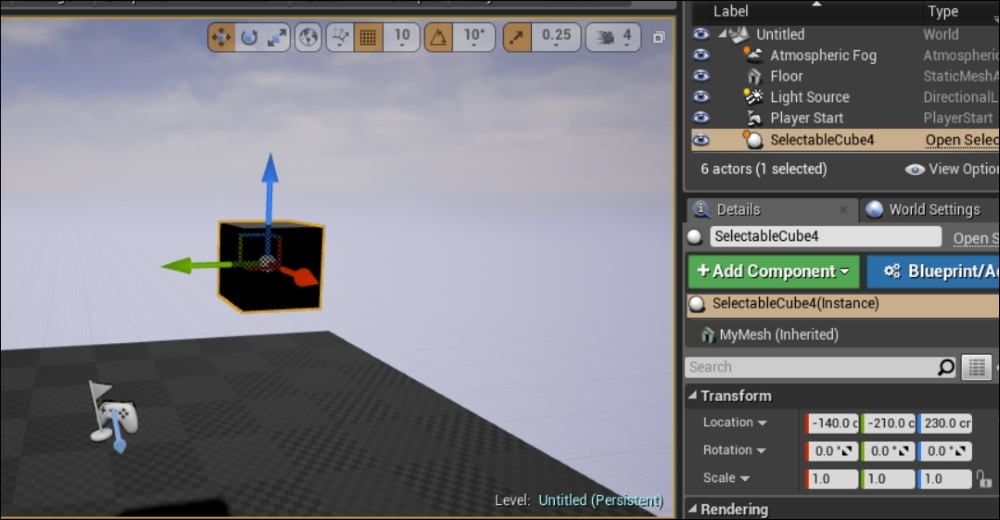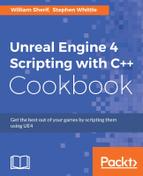One side effect of UInterfaces allowing inheritance in C++ is that we can override default implementations in subclasses as well as in Blueprint. This recipe shows you how to do so.
Follow the recipe Calling native UInterface functions from C++ in which a Physics Cube is created so that you have the class ready.
- Create a new Interface called
Selectable. - Define the following functions inside
ISelectable:virtual bool IsSelectable(); virtual bool TrySelect(); virtual void Deselect();
- Provide a default implementation for functions like this:
boolISelectable::IsSelectable() { GEngine->AddOnScreenDebugMessage(-1, 1, FColor::Red, "Selectable"); return true; } boolISelectable::TrySelect() { GEngine->AddOnScreenDebugMessage(-1, 1, FColor::Red, "Accepting Selection"); return true; } voidISelectable::Deselect() { unimplemented(); } - Create a class based on
APhysicsCubecalledSelectableCube. #include "Selectable.h"inside theSelectableCubeclass' header.- Modify the
ASelectableCubedeclaration like this:class UE4COOKBOOK_API ASelectableCube : public APhysicsCube, public ISelectable
- Add the following functions to the header:
ASelectableCube(); virtual void NotifyHit(class UPrimitiveComponent* MyComp, AActor* Other, class UPrimitiveComponent* OtherComp, bool bSelfMoved, FVectorHitLocation, FVectorHitNormal, FVectorNormalImpulse, constFHitResult& Hit) override;
- Implement the functions:
ASelectableCube::ASelectableCube() : Super() { MyMesh->SetNotifyRigidBodyCollision(true); } voidASelectableCube::NotifyHit(class UPrimitiveComponent* MyComp, AActor* Other, class UPrimitiveComponent* OtherComp, bool bSelfMoved, FVectorHitLocation, FVectorHitNormal, FVectorNormalImpulse, constFHitResult& Hit) { if (IsSelectable()) { TrySelect(); } } - Create a new class, called
NonSelectableCube, which inherits fromSelectableCube. NonSelectableCubeshould override the functions fromSelectableInterface:virtual bool IsSelectable() override; virtual bool TrySelect() override; virtual void Deselect() override;
- The implementation file should be altered to include the following:
boolANonSelectableCube::IsSelectable() { GEngine->AddOnScreenDebugMessage(-1, 1, FColor::Red, "Not Selectable"); return false; } boolANonSelectableCube::TrySelect() { GEngine->AddOnScreenDebugMessage(-1, 1, FColor::Red, "Refusing Selection"); return false; } voidANonSelectableCube::Deselect() { unimplemented(); } - Place an instance of
SelectableCubeinto the level at a certain range above the ground, and play your game. You should get messages verifying that the actor is selectable, and that it has accepted the selection, when the cube hits the ground.
- Remove
SelectableCubeand replace it with an instance ofNonSelectableCubeto see the alternative messages indicating that this actor isn't selectable, and has refused selection.
- We create three functions inside the
Selectableinterface. IsSelectablereturns a Boolean to indicate if the object is selectable. You could avoid this and simply useTrySelect, given that it returns a Boolean value to indicate success, but, for example, you might want to know if the object inside your UI is a valid selection without having to actually try it.TrySelectactually attempts to select the object. There's no explicit contract forcing users to respectIsSelectablewhen trying to select the object, soTrySelectis named to communicate that the selection may not always succeed.- Lastly,
Deselectis a function added to allow objects to handle losing the player selection. This could involve changing the UI elements, halting sounds or other visual effects, or simply removing a selection outline from around the unit. - The default implementations of the functions return
trueforIsSelectable(the default is for any object to be selectable),trueforTrySelect(selection attempts always succeed), and issues a debug assert ifDeselectis called without being implemented by the class. - You could also implement
Deselectas a purevirtualfunction if you wish. SelectableCubeis a new class inheriting fromPhysicsCube, but also implementing theISelectableinterface.- It also overrides
NotifyHit, avirtualfunction defined inAActorthat triggers when the actor undergoes a RigidBody collision. - We call the constructor from
PhysicsCubewith theSuper()constructor call inside the implementation ofSelectableCube. We then add our own implementation, which callsSetNotifyRigidBodyCollision(true)on our static mesh instance. This is necessary, because by default, RigidBodies (such asPrimitiveComponentswith a collision) don't triggerHitevents as a performance optimization. As a result, our overriddenNotifyHitfunction would never be called. - Within the implementation of
NotifyHit, we call some of theISelectableinterface functions on ourselves. Given that we know we are an object that inherits fromISelectable, we don't need to cast to anISelectable*in order to call them. - We check to see if the object is selectable with
IsSelectable, and if so, we try to actually perform the selection usingTrySelect. NonSelectableCubeinherits fromSelectableCube, so we can force the object to never be selectable.- We accomplish this by overriding the
ISelectableinterface functions again. - Within
ANonSelectableCube::IsSelectable(), we print a message to the screen so we can verify that the function is being called, and then returnfalseto indicate that the object isn't selectable at all. - In case the user doesn't respect
IsSelectable(),ANonSelectableCube::TrySelect()always returnsfalseto indicate that the selection wasn't successful. - Given that it is impossible for
NonSelectableCubeto be selected,Deselect()callsunimplemented(), which throws an assert warning that the function was not implemented. - Now, when playing your scene, each time
SelectableCube/NonSelectableCubehits another object, causing a RigidBody collision, the actor in question will attempt to select itself, and print messages to the screen.
- Refer Chapter 6, Input and Collision, which shows you how to Raycast from the mouse cursor into the game world to determine what is being clicked on, and could be used to extend this recipe to allow the player to click on items to select them
..................Content has been hidden....................
You can't read the all page of ebook, please click here login for view all page.
